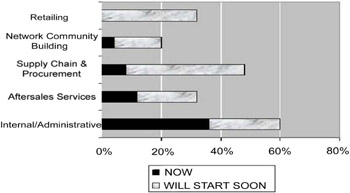Survey Results
|
|
The survey confirms that increased customer interaction is the top reason driving internet strategy for Asian auto companies. For the OEMs and suppliers, closer customer contact and supply chain and e-procurement cost savings are the main drivers. For the dealers, getting closer to existing customers and providing greater reach are the focal points for e-strategy. However, given the disparity among Asian auto markets, e-business value savings will differ from market to market. For example in Japan, supply chains are generally more effective than in the US, marginalizing e-business gains. The savings in Japan would come in its expensive distribution channel, where the many layers of middlemen could be bypassed using e-business. Throughout Asia, e-business is predicted to lower costs by one third in procurement, supply chain and average transaction costs.
The surveys revealed a questionable commitment to e-business in the Asian auto industry. Currently, most auto manufacturers use e-business only for internal administration (see Figure 1), and devote less than 0.5% of their total revenues to e-business infrastructure and processes. For suppliers in the industry, this figure is even lower. Despite all the talks of e-business, the development has been slow, with only 5–15% of IT budgets devoted to e-business. The current infrastructure in the industry is largely internally focused, incongruent to customer-orientation of e-business.

Figure 1: Current share of OEMs indicating level of e-enablement and its future
The survey shows that the e-business market in Asia is different. In Asia the proportion of car sales influenced by the internet is much lower than those of the US and the EU (15% vs 40%). There is a large gap in affordability, with the number of months' salary to buy a car in Asia often 10 times higher than the same figure in the West. While the US market has been purchasing goods on the internet for a couple of years, Asian web users have yet to perform many consumer and business transactions on the web. Culturally, Asians prefer to base consumer and business decisions on personal relationships. The region suffers from a shortage of skilled human resources, as well as a lack of economic scale. Middleman remain dominant in Asian commerce, and hinder the development of e-business in the region. All of these factors have led to an internet immaturity in the region, and demand for multinationals to develop a proprietary business model for the region.
According to the survey results, Internal conflict of interest was cited as a key obstacle to implementing e-business strategy. At the regional level, challenges to the expansion of e-business in Asia can be summarized as follows:
-
There is shortage of human resources, especially in non-Japanese markets.
-
Connectivity is still low due to the high proportion of poverty in the region.
-
There are obstacles crossing the many cultural boundaries in the region to achieve a sufficient level of transparency.
-
There is little standardization across markets.
-
Intellectual property protection measures are still lacking in most of the countries in the region.
At the industry level, there are also major e-business implementation bottlenecks across Asia:
-
Manufacturers risk alienating dealers as they replace elements of their function with portal sites.
-
How to pass savings on to customers.
-
E-procurement is not easy for engineered materials.
-
Organizational maturity of many suppliers is lacking.
-
The integration of several differing legacy systems is a difficult and expensive process.
-
There is conflict of interest with existing infrastructure.
-
Organizing sales around infrastructure threatens to up-end the current system.
-
The Internet only provides the means to communicate; some companies are not necessarily willing to share information.
|
|
EAN: 2147483647
Pages: 224